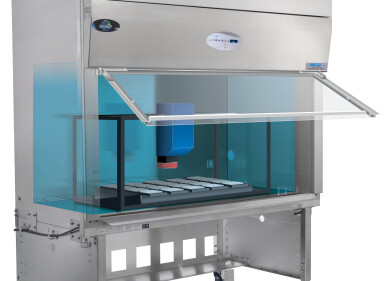Laboratory Products
Novel Spinning Drop Tensiometer Provides a New Level of Interfacial Tension Measurement
Jun 02 2015
The Spinning Drop Tensiometer – SDT, from Krüss GmbH, measures interfacial and surface tension with a high degree of accuracy and a particularly wide measuring range of 10-6 to 80 mN/m. The SDT is the ideal solution for the quality control and development of emulsions and surfactants thanks to its enormous bandwidth, low number of samples and simple handling during preparation. Exact capture of extremely low interfacial tensions also makes the SDT an instrument particularly well-suited for analysing the interfacial behaviour of milli-emulsions and micro-emulsions, for example for tertiary oil recovery or the pharmaceutical branch.
With the spinning drop method, measurement of the interfacial and surface tension is carried out by analysing the video image of a drop or a bubble surrounded by fluid in a rotating capillary. A high-resolution USB3 camera and an exactly controlled precision motor with excellent speed constancy are among the most important components of the SDT, combined with the intelligent and robust image evaluation algorithms of the software ADVANCE.
In addition to the standard Vonnegut method, the ADVANCE software’s spectrum of methods also encompasses an evaluation of the drop shape in accordance with Young-Laplace. This method reduces the rotational speed needed for high interfacial and surface tensions. Thus, the instrument measures not only extremely low interfacial tensions but also – at a rotational speed of up to 15.000 rpm – the surface tension of aqueous solutions with no problem at all.
One of the outstanding features of the SDT lies in the especially simple procedure for changing the samples. The capillary is first filled with surrounding liquid while dismounted. Its specially shaped cap also serves as a holder for the drop liquid which enters the capillary when the cap is closed. The capillary is then placed in its holder with just one simple click.
The speedy capillary changeover is achieved not least by the forgoing of a liquid temperature control, which at the same time saves the need for an additional thermostat. The integrated electric heater controls the target temperature quickly and accurately and is characterised by its high temperature stability. A cryostat can also be connected for analyses carried out at below room temperature. An accurate infrared sensor measures the temperature contactless and reproduces the thermal conditions directly at the place of measurement.
Digital Edition
International Labmate 49.6 - Sept 2024
September 2024
Chromatography Articles - HPLC gradient validation using non-invasive flowmeters Mass Spectrometry & Spectroscopy Articles - From R&D to QC, making NMR accessible for everyone: Putting NMR...
View all digital editions
Events
Oct 08 2024 Gothenburg, Sweden
Oct 09 2024 Birmingham, UK
Oct 09 2024 NEC, Birmingham, UK
Oct 15 2024 Milan, Italy
Oct 17 2024 Dhaka, Bangladesh







.jpg)










